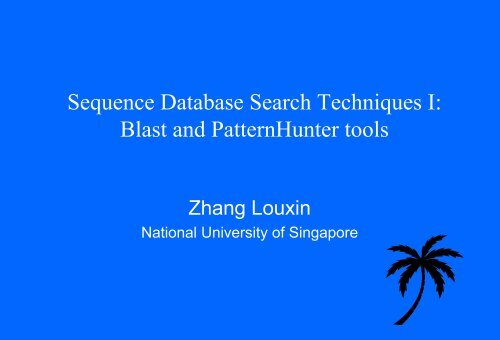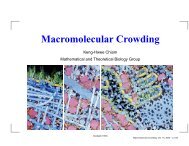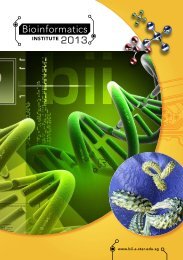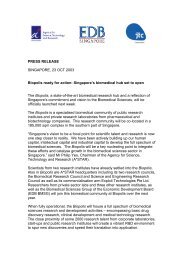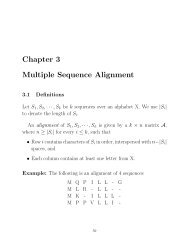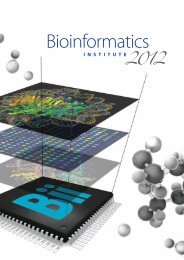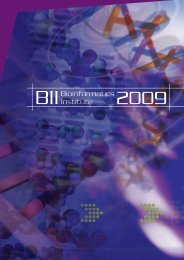Sequence Database Search Techniques I: Blast and PatternHunter ...
Sequence Database Search Techniques I: Blast and PatternHunter ...
Sequence Database Search Techniques I: Blast and PatternHunter ...
You also want an ePaper? Increase the reach of your titles
YUMPU automatically turns print PDFs into web optimized ePapers that Google loves.
<strong>Sequence</strong> <strong>Database</strong> <strong>Search</strong> <strong>Techniques</strong> I:<br />
<strong>Blast</strong> <strong>and</strong> <strong>PatternHunter</strong> tools<br />
Zhang Louxin<br />
National University of Singapore
Outline<br />
1. <strong>Database</strong> search<br />
2. BLAST (<strong>and</strong> filtration technique)<br />
3. <strong>PatternHunter</strong> (empowered with spaced seeds)<br />
4. Good spaced seeds
1. <strong>Sequence</strong> database search<br />
• Problem: Find all highly similar segments (called<br />
homologies) in the query sequence <strong>and</strong><br />
sequences in a database, which are listed as local<br />
alignments.<br />
>gi|19111785|gb|AC060809.7| Homo sapiens chromosome 15,<br />
clone RP11-404B13, complete sequence Length = 172123<br />
Query: 116 g a a -- t t t t a c a c t t t c a a a -- g 136<br />
| | | | | | | | | | | | | | | | | |<br />
Sbjct: 131078 g a a a t t t g a c a c t t t c a a a g g 131098
Local alignment<br />
• Mathematically, the local alignment problem is to find<br />
a local alignment with maximum score.<br />
• Smith-Waterman Algorithm<br />
--- dynamic programming algorithm<br />
--- output optimal local alignments<br />
--- quadratic time O(mn), <strong>and</strong> so not scalable.
Scalability is critical<br />
• The genetic data grows exponentially.<br />
Nucleotides(billion)<br />
8<br />
7<br />
6<br />
5<br />
4<br />
3<br />
2<br />
1<br />
0<br />
1980 1985 1990 1995 2000<br />
Years<br />
• Genomes: Human, Mouse, Fly, <strong>and</strong> etc.<br />
• To meet this dem<strong>and</strong>, many programs were created:<br />
<strong>Blast</strong> (Mega<strong>Blast</strong>, WU- <strong>Blast</strong>, psi-<strong>Blast</strong>),<br />
FSATA,SENSEI, MUMmer, BLAT, etc.<br />
30 billions<br />
in 2005.
2. <strong>Blast</strong> Family<br />
• Based on filtration technique.<br />
1. Filtering stage: identify short matches of length k (=11)<br />
in both query <strong>and</strong> target sequences.<br />
2. Alignment stage: extend each match found in Stage 1 into<br />
a gapped alignment, <strong>and</strong> report it if significance.<br />
• Its running time is linear time c (m+n), where<br />
constant factor c depends on k.
ACTCATCGCTGATGCCCATCCTCACTTTAAAAATATATAGACTAGGGCATTGGGA<br />
GCAAAGGATTTACGCATTGATGCCCATCCTGCAGGCGACTAGGGCATTGG
Dilemma<br />
• Increasing match size k speeds up the program, but<br />
loses sensitivity (i.e. missing homology region that are highly<br />
similar but do not contain k consecutive base matches).<br />
• Decreasing size k gains sensitivity but loses speed.<br />
>gi|19111785|gb|AC060809.7| Homo sapiens chromosome 15,<br />
clone RP11-404B13, complete sequence Length = 172123<br />
Can the dilemma be solved?<br />
We need to have both sensitivity <strong>and</strong> speed.<br />
Query: 116 g a a -- t t t t a c a c t t t c a a a -- g 136<br />
| | | | | | | | | | | | | | | | | |<br />
Sbjct: 131078 g a a a t t t g a c a c t t t c a a a g g 131098
Dilemma<br />
• Increasing match size k speeds up the program, but<br />
loses sensitivity (i.e. missing homology regions that are highly<br />
similar but do not contain k consecutive base matches).<br />
• Decreasing match size k gains sensitivity but loses<br />
speed.<br />
Can the dilemma be solved?<br />
We need to have both sensitivity <strong>and</strong> speed.
3. Spacing out matching positions<br />
--- <strong>PatternHunter</strong>’s approach<br />
(Ma, Tromp, <strong>and</strong> Li, Bioinformatics, 2002)<br />
• Filtering stage: looks for matches in k(=11)<br />
noncontinous positions specified by<br />
an optimal pattern, for example,<br />
1**11*1<br />
or several patterns.<br />
Such a pattern is called a spaced seed.<br />
• Alignment stage: same as <strong>Blast</strong>.<br />
G C A A T T G C C G G A T C T T<br />
I I I I I<br />
I<br />
G C G A T T G C T G G C T C T A<br />
G C A A T T G C C G G A T C T T<br />
I I I I I<br />
G C G A T T G C T G G C T C T A
Simple idea makes a big difference<br />
• A good spaced seed not only increases hits in homology<br />
regions, but also reduces running time.<br />
In a region of length 64 with similarity 70%, PH has<br />
probability of 0.466 to hit vs <strong>Blast</strong> 0.3,<br />
50% increase.<br />
Time reduction comes from that the average number of<br />
matches found in Stage 1 decreases.<br />
• Adopted by BLASTZ, Mega<strong>Blast</strong> progams. Used by Mouse<br />
Genome Consortium.
Simple idea makes a big difference<br />
• A good spaced seed not only increases hits in homology<br />
regions, but also reduces running time.<br />
In a region of length 64 with similarity 70%, PH has<br />
probability of 0.466 to hit vs <strong>Blast</strong> 0.3,<br />
50% increase.<br />
Time reduction comes from that the average number of<br />
matches found in Stage 1 decreases.<br />
• Adopted by BLASTZ, Mega<strong>Blast</strong> progams. Used by Mouse<br />
Genome Consortium.
Not just spaced seed<br />
• <strong>PatternHunter</strong> uses a variety of advanced data<br />
structures including priority queues, red-black tree ,<br />
queues, hash tables.<br />
• Several other algorithmic improvements.
Comparison with <strong>Blast</strong>n, Mega<strong>Blast</strong><br />
(A slide from M. Li)<br />
• On Pentium III 700MH, 1GB<br />
<strong>Blast</strong>n MB PH<br />
E.coli vs H.inf 716s 5s/561M 14s/68M<br />
Arabidopsis 2 vs 4 -- 21720s/1087M 498s/280M<br />
Human 21 vs 22 -- -- 5250s/417M<br />
61M vs 61M<br />
3hr37m/700M<br />
100M vs 35M<br />
6m<br />
Human vs Mouse<br />
20 days<br />
• All with filter off <strong>and</strong> identical parameters<br />
• 16M reads of Mouse genome against Human genome for Whiteheads &<br />
UCSC. Best <strong>Blast</strong> program takes 19 years at the same sensitivity (seed<br />
length 11).
Questions<br />
• Why is the PH seed better than <strong>Blast</strong> consecutive seed<br />
(11111111111 for weight 11) of the same weight?<br />
PH spaced seed is `less regular’ than <strong>Blast</strong> seed;<br />
A r<strong>and</strong>om sequence should contain more `less regular’ patterns<br />
• Are all spaced seeds better than <strong>Blast</strong><br />
seed of the same weight ?<br />
1*1*1*1*1*1*1 is worse than 1111111<br />
• Which spaced seeds are optimal?<br />
A difficult problem. No polynomial-time algorithm is known for finding them
4. Identifying Good Spaced Seed<br />
--- Ungapped alignment model<br />
• Given two DNA sequences S’, S’’ with similarity p,<br />
we assume the events that they have a base-match<br />
at each position are jointly independent, each with<br />
probability p.<br />
Under this model, an ungapped alignment<br />
between S’ <strong>and</strong> S’’ corresponds to a 0-1 r<strong>and</strong>om<br />
sequence S in which 0 <strong>and</strong> 1 appear in each<br />
position with probability 1-p <strong>and</strong> p respectively.
Example<br />
G C A A T T G C C G G A T C T T<br />
I I I I I I I I I I I I<br />
G C G A T T G C T G G C T C T A<br />
Translate a match to 1 <strong>and</strong> a mismatch to 0<br />
1 1 0 1 1 1 1 1 0 1 1 0 1 1 1 0<br />
If spaced seed 1**11*1 is used, there are two seed<br />
matches in the alignment.<br />
G C A A T T G C C G G A T C T T<br />
I I I I I I<br />
G C G A T T G C T G G C T C T A<br />
G C A A T T G C C G G A T C T T<br />
I I I I I<br />
G C G A T T G C T G G C T C T A<br />
1 1 0 1 1 1 1 1 0 1 1 0 1 1 1 0 1 1 0 1 1 1 1 1 0 1 1 0 1 1 1 0
Definitions<br />
• Under the model of similarity p,<br />
(the sensitivity of a spaced seed Q)<br />
||<br />
(the prob. of Q hitting a r<strong>and</strong>om 0-1 sequence of a fixed length N=64)<br />
• Sensitivity depends on the similarity p if N is fixed.<br />
• Optimal spaced seed is the one with largest sensitivity,<br />
over all the seeds of same weight..
Computing Sensitivity<br />
Qn<br />
1. Consecutive Seed B=1111…1 of weight w.<br />
Let S be a r<strong>and</strong>om 0-1sequence of length n<br />
A i<br />
Let be the event of the seed B occurring at position k =w+1,<br />
Q<br />
n<br />
= P[(<br />
A1<br />
∪ A2<br />
= Q + P[<br />
A<br />
= Q<br />
= P[<br />
A<br />
n−1<br />
n−1<br />
+<br />
1<br />
p<br />
∪<br />
w<br />
1<br />
A<br />
2<br />
∪L∪<br />
A<br />
A L A<br />
(1 −<br />
2<br />
∪L∪<br />
A<br />
n<br />
n−1<br />
p)(1<br />
− Q<br />
n<br />
n<br />
]<br />
−1)<br />
∪ A<br />
A ]<br />
n−w−1<br />
)<br />
1<br />
A<br />
2<br />
L A<br />
n−1<br />
A<br />
n<br />
]<br />
Let<br />
Q<br />
n<br />
Q<br />
w<br />
= Q<br />
1<br />
− p ( 1−<br />
p)<br />
Q<br />
w−<br />
=1−<br />
Qn<br />
n n−<br />
n−<br />
1
(1-Sensitivity) grows exponentially with length<br />
Q<br />
n<br />
≈<br />
βλ<br />
(Buhler et al.)<br />
n<br />
Consecutive seed
Expected Number of Exact Matches<br />
Let Q be a spaced seed of weight w <strong>and</strong> length L.<br />
Under our model, the expected number E of the exact matches found in an ungapped<br />
alignment of length n is equal to the expected value of times T the seed Q occurs in<br />
an 0-1 r<strong>and</strong>om sequence of length n.<br />
Consider a length-N ungapped alignment with similarity p <strong>and</strong> hence a length-N 0-1<br />
r<strong>and</strong>om sequence in which 1 appears with probability p in each<br />
A<br />
position. Let j denote the event that seed Q occurs at position j ( )<br />
<strong>and</strong> be the indicator function of A :<br />
I<br />
j<br />
j<br />
L<br />
≤<br />
j<br />
≤<br />
N<br />
Then<br />
I<br />
I<br />
j<br />
j<br />
A i<br />
A i<br />
=1 if the event occurs<br />
=0 if the event does not occur<br />
T =<br />
∑L<br />
≤ j ≤ N<br />
∑<br />
I<br />
j<br />
∑<br />
E ( T ) =<br />
)<br />
w<br />
E(<br />
I =<br />
= − +<br />
L≤<br />
j≤N<br />
j<br />
) P[<br />
A<br />
L≤<br />
j≤N<br />
j<br />
] ( N L 1 p
Good Spaced Seeds<br />
• We identified good spaced seeds of weight from<br />
9 to 18 in terms of their optimum span (i.e. the<br />
similarity interval in which the seed is optimal).
Experimental Validation<br />
• We conducted genomic sequence comparison with<br />
<strong>PatternHunter</strong> on<br />
(i) H. influenza (1.83Mbp) <strong>and</strong> E. coli (4.63Mbp)<br />
(ii) A 1.7Mbp segment in mouse ChX<br />
<strong>and</strong> a 1Mbp segment in human ChX<br />
(iii) A 1.3Mbp segment in mouse Ch10<br />
<strong>and</strong> a 2Mbp segment in human Ch19<br />
• We evaluate a spaced seed by relative performance.<br />
(setting the performance of <strong>Blast</strong> seed as 1)
H. Influenza vs E. coli<br />
Threshold 35<br />
Threshold 50<br />
1.3<br />
1.2<br />
C<br />
P<br />
1.3<br />
1.2<br />
1.1<br />
G<br />
1.1<br />
1<br />
1<br />
0.9<br />
0.9<br />
0.8<br />
8 9 10 11 12 13 14 15<br />
0.8<br />
8 9 10 11 12 13 14 15<br />
Threshold 70<br />
Threshold 100<br />
1.3<br />
1.3<br />
1.2<br />
1.2<br />
1.1<br />
1.1<br />
1<br />
1<br />
0.9<br />
0.9<br />
0.8<br />
8 9 10 11 12 13 14 15<br />
0.8<br />
8 9 10 11 12 13 14 15
Human X vs Mouse X<br />
Threshold 35<br />
Threshold 50<br />
1.5<br />
1.4<br />
1.3<br />
1.2<br />
1.1<br />
C<br />
P<br />
G<br />
1.5<br />
1.4<br />
1.3<br />
1.2<br />
1.1<br />
1<br />
0.9<br />
1<br />
0.9<br />
0.8<br />
8 9 10 11 12 13 14 15<br />
0.8<br />
8 9 10 11 12 13 14 15<br />
Threshold 70<br />
Threshold 100<br />
1.4<br />
1.3<br />
1.3<br />
1.2<br />
1.1<br />
1<br />
0.9<br />
0.8<br />
1.2<br />
1.1<br />
1<br />
0.9<br />
0.8<br />
0.7<br />
8 9 10 11 12 13 14 15<br />
0.7<br />
8 9 10 11 12 13 14 15
Human 19 vs Mouse 10<br />
Threshold 35<br />
Threshold 50<br />
1.8<br />
1.7<br />
1.6<br />
1.5<br />
1.4<br />
1.3<br />
1.2<br />
1.1<br />
1<br />
0.9<br />
C<br />
P<br />
G<br />
8 9 10 11 12 13 14 15<br />
1.8<br />
1.7<br />
1.6<br />
1.5<br />
1.4<br />
1.3<br />
1.2<br />
1.1<br />
1<br />
0.9<br />
8 9 10 11 12 13 14 15<br />
Threshold 70<br />
Threshold 100<br />
1.8<br />
1.7<br />
1.6<br />
1.5<br />
1.4<br />
1.3<br />
1.2<br />
1.1<br />
1<br />
0.9<br />
8 9 10 11 12 13 14 15<br />
1.8<br />
1.7<br />
1.6<br />
1.5<br />
1.4<br />
1.3<br />
1.2<br />
1.1<br />
1<br />
0.9<br />
8 9 10 11 12 13 14 15
Some Recommendations<br />
• There are two competing seeds of weight 11<br />
Optimum Interval<br />
111*1**1*1**11*111 (PH seed) [61%, 73%]<br />
111**1*11**1*1*111 (Buhler et al) [74%, 96%]<br />
PH seed is good for distant homology search,<br />
while the latter one for aligning sequences with high<br />
similarity.
Recommendations (con’t)<br />
• Spaced seed 111*1*11*1**11*111<br />
of weight 12 is probably the best<br />
for fast genomic database search<br />
1<br />
0.9<br />
0.8<br />
0.7<br />
111*1*11*1**11*111<br />
0.6<br />
(1) faster <strong>and</strong> more sensitive than the <strong>Blast</strong><br />
default seed weight 11<br />
(2) widest optimum interval [59%, 96%]<br />
0.2<br />
(3) good for aligning coding regions since<br />
0.1<br />
it contains 4 repeats of 11* in its 6-codon<br />
11111111111<br />
0<br />
span in a reverse direction:<br />
0.1 0.2 0.3 0.4 0.5 0.6 0.7 0.8 0.9 1<br />
sensitivity<br />
0.5<br />
0.4<br />
0.3<br />
similarity<br />
11 1*1 *11 *1* *11 *11 1
Recommendations (con’t)<br />
• The larger the weight of a spaced seed,<br />
the narrower its optimum interval. So, for database search,<br />
a larger weight spaced seed should be carefully selected.
References<br />
Altschul, S.F. et al. "Basic local alignment search tool."<br />
J. Mol. Biol. 1990; 215:403-410.<br />
Altschul, S.F. Gapped BLAST <strong>and</strong> PSI-BLAST: a new generation of protein<br />
database search programs." Nucleic Acids Res. 1997; 25:3389-3402.<br />
Ma, B., Tromp, J., Li, M., "<strong>PatternHunter</strong>: faster <strong>and</strong><br />
more sensitive homology search", Bioinformatics 2002;18:440-5<br />
Choi, K.P. Zeng F. <strong>and</strong> Zhang L.X., “Good Spaced Seeds for<br />
Homology search”, Bioinformatics 2004 (to appear).<br />
http://www.math.nus.edu.sg/~matzlx/papers/Bio2003_105.pdf
Filtration-based Homology <strong>Search</strong> Algorithm<br />
• Filtering stage: look for matches in k(=11)<br />
noncontinous positions specified by a spaced seed<br />
such as 1**11*1 or several seeds.<br />
• Alignment stage: Extend matches found in above<br />
stage into an (ungapped or gapped) alignment.<br />
G C A A T T G C C G G A T C T T<br />
I I I I I<br />
I<br />
G C G A T T G C T G G C T C T A<br />
G C A A T T G C C G G A T C T T<br />
I I I I I<br />
G C G A T T G C T G G C T C T A<br />
Optimal spaced seeds have larger hitting prob., but smaller expected<br />
number of hits found in stage 1 in an alignment.
1. BLASTP<br />
Protein <strong>Sequence</strong> <strong>Database</strong> <strong>Search</strong>
Amino Acid Substitution Score Matrixes<br />
The theory is fully developed for scores used to find<br />
ungapped local alignments.<br />
Let F be a class of protein sequences in which amino acid i has<br />
q background frequency i , <strong>and</strong> each match of residue i verse<br />
residue j has target frequency .<br />
q i<br />
q ij<br />
q ij<br />
For finding local sequence comparison in F, up to a constant scaling<br />
factor, every appropriate substitution score matrix ( s ij<br />
) is uniquely<br />
determined by { , }:<br />
s =<br />
ij<br />
qij<br />
ln(<br />
q q<br />
i<br />
j<br />
)
Idea:<br />
In scoring a local alignment, we would like to assess how strong<br />
the length-n alignment of x <strong>and</strong> y can be expected from chance alone<br />
Prob[ x <strong>and</strong> y have common ancestor]<br />
P=<br />
Prob[ x <strong>and</strong> y are aligned by chance]<br />
Let<br />
x<br />
=<br />
x x Lx<br />
, y = y y L y<br />
1 2 n 1 2 n<br />
P<br />
=<br />
∏ xi<br />
yi<br />
q<br />
1≤ i≤n<br />
= ∏<br />
xi<br />
yi<br />
ln P = ∑<br />
∏( qx<br />
qy<br />
) 1≤i≤n<br />
q<br />
i i<br />
x<br />
q<br />
i y<br />
1≤i≤<br />
i<br />
1≤i≤n<br />
q<br />
n<br />
⎛<br />
ln⎜<br />
⎝<br />
q<br />
q<br />
x<br />
x<br />
i<br />
i<br />
y<br />
q<br />
i<br />
y<br />
i<br />
⎞<br />
⎟<br />
⎠
PAM <strong>and</strong> BLOSUM Substitution Matrices<br />
Hence, all substitution matrices are implicitly of log-odds form.<br />
But how to estimate the target frequencies?<br />
Different methods have been used for the task <strong>and</strong> result in two<br />
series of substitution matrices.<br />
PAM Matrices: the target frequencies were estimated from the<br />
observed residue replacements in closely related proteins<br />
within a given evolutionary distance (Dayhoff et al. 1978).<br />
BLOSUM Matrices: the target frequencies were estimated from<br />
multiple alignments of distantly related protein regions directly<br />
(Henikoff & Henikoff, 1992).
DNA vs. Protein Comparison<br />
If the sequences of interest are code for protein,<br />
it is almost always better to compare the protein translations<br />
than to compare the DNA sequences directly.<br />
The reason is (1) many changes in DNA sequences do<br />
not change protein, <strong>and</strong> (2) substitution matrices for<br />
amino acids represents more biochemical information.
Statistics of Local Ungapped Alignment<br />
It is well understood. The theory is based on the following<br />
simple alignment model:<br />
i). All the amino acid appear in each position independently<br />
with specific background probabilities.<br />
ii). the expected score for aligning a r<strong>and</strong>om pair of amino<br />
acid is required to be negative:<br />
∑<br />
p<br />
1≤i,<br />
j≤20<br />
i<br />
p<br />
j<br />
s<br />
ij<br />
<<br />
0
Statistics 2: E-value<br />
The BLAST program was designed to find all the maximal local<br />
ungapped alignments whose scores cannot be improved by<br />
extension or trimming. These are called high-scoring segment<br />
pairs (HSPs).<br />
In the limit of sufficiently large sequence lengths m <strong>and</strong> n,<br />
the expected number (E-value) of HSPs with score at least S<br />
is given by the formula:<br />
E<br />
=<br />
Kmne<br />
−λS<br />
Where K <strong>and</strong> lambda can be considered as scales for the database<br />
size <strong>and</strong> the scoring system respectively.
Statistics 3: P-Value<br />
E-Value:<br />
E<br />
=<br />
Kmne<br />
−λS<br />
The number of r<strong>and</strong>om HSPs with score >= S can be described<br />
by a Poisson distribution. This means that the probability of<br />
finding exactly x HSPs with score >=S is given by:<br />
e<br />
−E<br />
x<br />
E<br />
x!<br />
By setting x=0, the probability of finding at least one such HSP is<br />
1− e −E<br />
This is called the P-value associated with score S.
References<br />
1. Karlin, S. & Altschul, S.F. (1990) "Methods for assessing the statistical significance of<br />
molecular sequence features by using general scoring schemes."<br />
Proc. Natl. Acad. Sci. USA 87:2264-2268.<br />
2. Dembo, A., Karlin, S. & Zeitouni, O. (1994) "Limit distribution of maximal nonaligned<br />
two-sequence segmental score." Ann. Prob. 22:2022-2039.<br />
3. Dayhoff, M.O., Schwartz, R.M. & Orcutt, B.C. (1978) "A model of evolutionary<br />
change in proteins." In "Atlas of Protein <strong>Sequence</strong> <strong>and</strong> Structure," Vol. 5, Suppl. 3 (ed.<br />
M.O. Dayhoff), pp. 345-352. Natl. Biomed. Res. Found., Washington, DC.<br />
4. Henikoff, S. & Henikoff, J.G. (1992) "Amino acid substitution matrices from protein<br />
blocks." Proc. Natl. Acad. Sci. USA 89:10915-10919. (PubMed)


